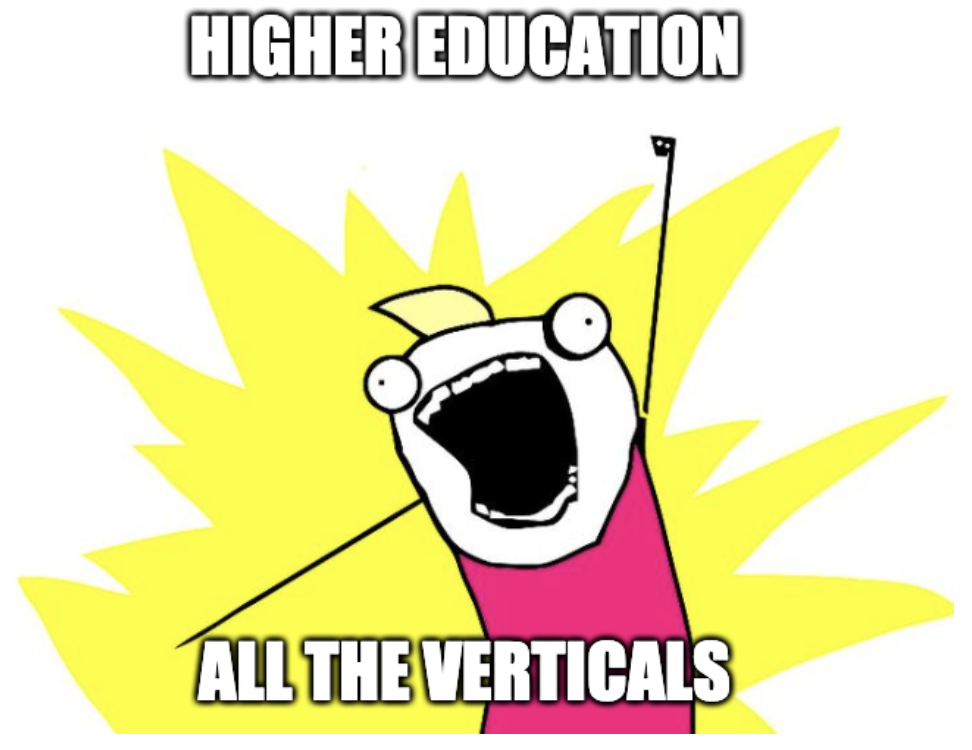Dear Tech Vendors…Higher Education is ALL the Verticals
Higher Education isn't a vertical. It's ALL verticals. A sufficiently sized campus is likely akin to a small city.

Having worked in Higher Education IT for 20 years, I’m continually surprised by vendors’ lack of understanding about what Higher Education is, and what Higher Education isn’t (spoiler, it’s everything; it’s never not something).
A year or two ago, a kind of inside-joke emerged between me and some colleagues, where we’d see how long it would take for someone in a meeting to say “Higher Education isn’t a vertical. It’s ALL verticals.” We found ourselves having to re-explain this concept many times over to vendors or colleagues who joined from private sector jobs. This is especially true for larger vendors that provide IaaS, PaaS and SaaS….who come to the table expecting a discussion about what they can offer “higher education.” Quickly they realize “higher education” isn’t a single thing and therefore possibly cannot give a single answer without considering the whole campus impact.
“Higher Education isn’t a vertical. It’s ALL verticals”
Autonomous and independently funded researchers, veterinary services, urban planning, fundraising, alumni affairs, nuclear reactors, maker spaces, legal, marketing, private/public partnerships, government-funded programs, golf-courses, restaurants, facilities & housekeeping, real estate, financial operations, credit card processing with PCI compliance, power generation, giant laundry facilities, massive athletics stadiums, retail merchandising…these things and more are commonplace on higher education campuses.
Some campuses are more akin to small cities, or small cities within a larger city, all with different leaders.
Many vendors have product lines or sales or customer success teams identified with expertise for different verticals. And a lot of the time, Higher Education is one of them, just like Healthcare, or Public Sector, or Financial Services. And it is true…Higher Education is a vertical….but only in the same way that a Matryoshka doll is “a” doll.

A simple example… healthcare
Some Universities operate full-fledged hospitals. But even those that don’t have a hospital probably have a Student Health Center. So, if you’re going to keep track, go ahead and add HIPAA to the list of things Higher Ed IT needs to care about.

How about public safety?
Many campuses have Public Safety offices or full police forces that work in tandem with the city/county police, and so of course Higher Ed IT needs to facilitate public safety operations, security personnel, emergency communications, criminal records systems, digital forensic requirements etc. Add those to the list too.

Users who live & sleep at the “office”?
How about a vertical where the majority of their users (students) literally eat, sleep, play, learn, and generally live at your place of work. That means a network (wireless of course) that can support the business / academic / operations needs of the institution, as well as students too. Don’t forget families, friends, summer camp attendees, and random guests who wander onto campus and need to get online, while IT has to comply with compliance and security requirements along the way.
Higher Ed supports students who want to play E-Sports without lag, and stream themselves on Twitch, or maybe just watch petabytes of cat videos on YouTube (or do they just watch cats on TikTok now?…im showing my age). Don’t forget students want to bring every new console or smart device that they were using at home, and use it in their residence hall. How many corporate offices have a Bring-Your-Own-Console policy that lets Sally from Accounting play Playstation on the corporate network?
Higher Education vs K-12
It seems K-12 is closer to what some vendors think of when someone says “education.” Kids in chairs, learning from teachers, needing a decent network, smart board at the front of the class, and laptops for all, and everyone leaves at the end of the day, right?
It’s just as important for vendors to understand that Higher Education is significantly different to K-12. The needs, regulations, funding models, verticals that you find on a higher ed campus are just on a massively different scale than K-12. Anyone want to be an expert on both COPPA and FERPA?
And before you think at least that’s an easy line to draw between Higher Education and K-12…. some universities operate or have affiliations with K-12 schools too….like this one.
Higher Education vs Higher Education
The distance between K-12 and Higher Education is large, but the gap can be even larger between a massive public/state university system institution with 50,000+ students, and a small private liberal arts college with 500 students.
The laws are different — state and federal regulations that drive a lot of requirements or processes at a public institution may be completely absent at a private institution. Freedom of Information Act requests, data retention and e-Discovery laws, hiring/firing laws….take your pick for which apply at School A vs School B.
Even within Higher Ed, the difference between schools’ needs is massive.
When you have 500 students, your IT staff may be a few people at most. You can do things manually, or write some scripts to help, but scale is not as big of an issue. Automation is a nice-to-have. When you’re administering an environment with 50,000 students, plus 10,000 staff, plus 1000 ancillary accounts for contractors, partners, etc, and trying to make sure that everyone can do their jobs…..automation is required. Finding vendors who understand the business processes involved in managing at that scale, and whose products operate efficiently at scale is vital.
Don’t sell me a product that dies when I need to look for something that one of my 100,000 users did 18 months ago. I don’t care that you told me it worked for that other school with 500 users.
Just because you have other education customers, doesn’t mean your solution will work for all educational institutions. A product that has poorly defined queries may work for 1000 users, but not for 100,000 users. And yes, we’ve seen this exact kind of issue with some pretty big vendors who didn’t optimize their reporting features.
Who’s in charge?
Vendors need to also understand the management/policy/process culture on the campus they’re dealing with.
Is it a public or private institution? Is it a university system, or a single campus entity? Central IT or distributed or both?
Just because you sold to the school down the street and they’ve been happy for 15 years, doesn’t mean your product will be successful on another campus. Different campuses have different approaches to software administration, change management, purchasing processes, security reviews, accessibility requirements, and implementation architecture.

Some schools have heavily centralized IT organizations, and others are VERY distributed. That means cold-calling the Biology Department Chair to try to sell him some shiny new software may get him to buy it on his P-CARD, but then you find out that it can’t be implemented because there are policies and review procedures that should have been handled beforehand…and now you find out the campus network doesn’t support the features required by your software anyway. That just ends up annoying the Biology Chair, and the vendor can’t show other customers a successful implementation. Sure it’s his fault too, but….
Vendors should ask questions ahead of time, because even though they might make a single sale, it still might not result in a happy customer.
Get connected
Acknowledging the various verticals within Higher Education already puts a vendor on solid ground when they’re engaging with a potential (or existing) institution.
Engaging with the community through conferences like EDUCAUSE can help get your foot in the door to learn more of course too. Then there are organizations like Internet2 who bring vendors and schools together to create higher-education-focused offerings like the NET+ program. Note: I’m not compensated anything by Internet2 or EDUCAUSE…I’ve just worked with them in various capacities over the years in Higher Ed.
Higher Education people talk to each other... a lot.
Vendors should know that people in Higher Education talk to each other. A lot. More than our private sector equivalents. Especially in technology circles. We aren’t in direct competition with another school. If we share knowledge that helps them roll out some new enterprise software, that’s a good thing..it’s not seen as us helping a competitor. As a result, we share success AND horror stories. We tell each other when a product or a vendor should be avoided like the plague.
If you’re a vendor who offers special pricing to ACME State University….the rest of us will probably find out and then ask why you’re charging some of us twice what you’re charging them for the same service / number of users etc.
Or if you’re the vendor who says your product requires no overhead or maintenance effort, but then after a year it consistently dies, or takes 3 people to maintain it…..we’re going to talk about that and make sure no other schools fall into the same trap.

ALL THE THINGS
To summarize….
- Higher Education is all the verticals, all the time.
Yeah, that pretty much sums it up :-)
Attributions
- Years of Higher Education Collaboration with Community Colleagues ;-)
- Years of discussion with vendors
- imgflip.com for “All the Things” meme
- Photo by LinkedIn Sales Solutions on Unsplash
- Photo by Tingey Injury Law Firm on Unsplash
- Photo by Owen Beard on Unsplash
- Photo by Simon Hurry on Unsplash
Next up — Software Licensing in Higher Education…one size does not fit all
